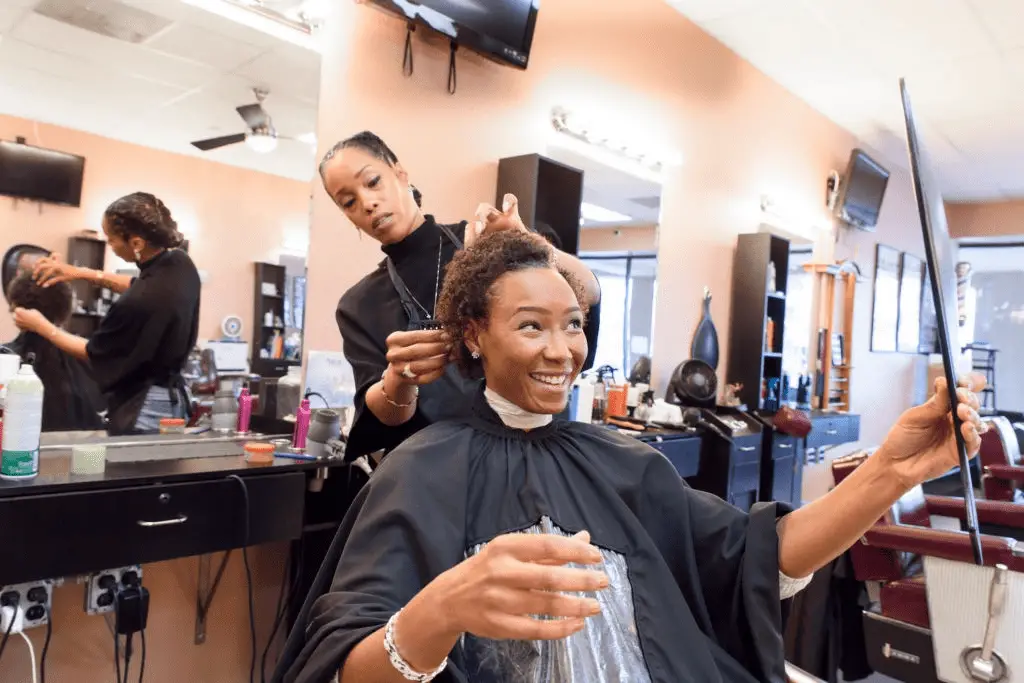Unfortunately, I can’t give you a one-schedule-fits-all sort of answer. However, there are several things that you need to consider to come up with the schedule that works best for you and your hair.
You should consider the growth rate of your hair (i.e. new growth), your hair texture, your level of patience with your hair, as well as how you style your hair regularly.
By the end of this guide, you should have a much better idea of how often to relax your hair according to the right schedule.
New Growth
“I have so much new growth!” That is a term that many of us use when we are ready to have our hair relaxed again. In a way, this is a good way to guage whether or not it is time for a touch-up.
Generally speaking, most people prefer to relax their hair every 8 weeks. Since hair grows on average 1/2 inch a month, it’s safe to assume that hair should have at least an inch of growth before getting a touch-up.
For some people, that could mean 6 weeks and for some people that could mean 10 weeks.
Having at least an inch of hair growth will provide room to apply the relaxer to only the new growth.
Relaxing your hair without enough new growth could lead to over-processing which can then lead to breakage and thinness.
Hair growth is only one thing to think about when getting touch-ups. Another one that is as equally important is hair texture.
Hair Texture
Depending upon your hair texture, you may need to adjust when you relax your hair from the typical 8 weeks.
Those with fine hair should play close attention to their hair to ensure that they understand how their hair reacts to relaxers especially during touch-ups.
For example, fine hair breaks down more easily by the chemicals in relaxers.
So, if you have a lot of new growth, your stylist will have to work quickly in order to get all of your new growth relaxed without risking damage by leaving the relaxer on sections for too long.
Also, with fine hair you should absolutely avoid relaxing too often because over-processing can be extremely damaging to fine hair.
If your hair is more on the coarse side, your stylist will need to make sure that the relaxer is left on your hair long enough for the chemical to break down the bonds in your hair that encourages straightness.
If you’ve waited an unusually long time to relax, it could pose a problem for your stylist as she tries to manage avoiding over-processing your hair while trying to ensure that you also get the level of straightness that you’re looking for.
Level of Patience
Your level of patience also plays a role in how often you relax your hair.
I hear a lot of talk about stretching relaxers. The premise of stretching relaxers is to eliminate over-processing and thus yield healthier hair.
One thing worth noting is that stretching relaxers requires a lot of patience!
When your hair has grown an inch giving you an inch of natural hair along with the rest of your hair being relaxed, it can pose a challenge in styling and caring for your hair.
You will have to treat your hair with extra special care when washing, conditioning, and styling. Your hair will tangle up more when being washed.
It will be more difficult to comb through the conditioner. And moreso, styling will be the biggest challenge of all. You’ll most likely have to spend more time getting your hair to look just right.
If you don’t practice patience when stretching relaxers, you can experience breakage since the line of demarcation (the point at which your newly grown natural hair meets your relaxed hair) is the most fragile area of your hair.
Hair Styling
When determining how often you should relax your hair, think about how you prefer to wear your hair on a daily basis.
Do you prefer your hair bone straight and swinging? Or do you prefer more of a fluffy, big curls look? Or maybe you wear your hair in braid outs or twists. All of these weigh in to how often you might want to relax your hair.
If you wear your hair bone straight, you will most likely want to get your hair relaxed regularly – each time you gain an inch of new growth or every 8-10 weeks.
Otherwise, you will have to spend extra time getting your roots straight and trying to avoid reversion.
If you don’t mind a more fluffy, curly look, you can go a little longer without relaxing because your new growth won’t be as much of an issue for your hair style.
Braid outs and twist outs offer a method of styling to help you go longer without relaxing your hair. These styles help you to blend in your natural hair to your relaxed hair.
Conclusion
In conclusion, there is no one quick answer to how often you relax your hair. You have to think about what is good for your hair and what is good for you.
You should pay attention to your hair’s growth rate, how you prefer to style your hair, your patience level, as well as your hair texture.
I hope this guide has helped you determine if you need to adjust your own relaxer schedule or if you’re already doing what’s best for your hair.


